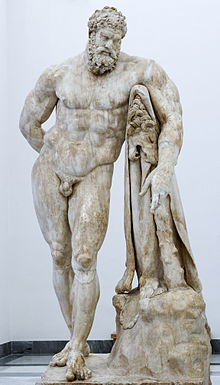مردانگی

مردانگی (انگریزی: Masculinity)، جسے مردانہ وجاہت یا مردانہ پن بھی کہا جاتا ہے، ان صفات، برتاؤ اورکرداروں کا مجموعہ ہے، جو لڑکوں اور آدمیوں سے متعلق ہیں۔ ایک سماجی نظام کے طور پر یہ ممتاز ہے اس تعریف سے جو حیاتیات کی رو سے جنس سے متعلق ہے۔[1][2] مردانگی کے معیارات ثقافتوں اور تاریخی ادوار میں مختلف رہے ہیں۔[3] یہ بھی بعض اقوال سے ثابت ہے کہ مرد و زن دونوں مردانہ صفات اور برتاؤ کا مظاہرہ کر سکتے ہیں۔[4]
مغربی دنیا میں مردانگی سے جڑی صفات میں طاقت، ہمت، آزادی، قیادت اور بار آوری شامل ہیں۔[5][6][7][8]
تاریخ میں عورتوں کا مردانگی سے متصف ہونا
[ترمیم]تاریخ میں کئی عورتیں ہمت و طاقت کا مظاہرہ کرتی ہوئی دیکھی گئی ہیں۔ اس وجہ سے ان کے کردار کو مردانہ کہا گیا ہے۔ ایسی ہی ایک شخصیت رانی لکشمی بائی تھی، جنھوں نے 1857ء میں ہندوستان کی پہلی جنگ آزادی میں لڑکر اپنا لوہا منوایا۔ ان کے میں ہندی میں کہا گیا ہے کہ خوب لڑی مردانی، ارے جھانسی واری رانی (ہندی: खूब लड़ी मरदानी, अरे झांसी वारी रानी[9]) تھی۔
مزید دیکھیے
[ترمیم]حوالہ جات
[ترمیم]- ↑ Ferrante, Joan (2008), "Gender and sexualities: with emphasis on gender ideals", in Ferrante، Joan، المحرر (1 يناير 2010). Sociology: a global perspective (ط. 7th). Belmont, California: Thomson Wadsworth. ص. 269–272. ISBN:9780840032041.
- ↑ "Gender, Women and Health: What do we mean by "sex" and "gender"?"۔ who.int۔ عالمی ادارہ صحت۔ 8 ستمبر 2014 میں اصل سے آرکائیو شدہ۔ اخذ شدہ بتاریخ 17 ستمبر 2014
- ↑ Kimmel، Michael S.؛ Aronson، Amy، المحررون (2004). Men and Masculinities: A Social, Cultural, and Historical Encyclopedia, Volume 1. Santa Barbara, Calif.: ABC-CLIO. ص. xxiii. ISBN:978-1-57-607774-0.تصنيف:صيانة الاستشهاد: استشهادات بمسارات غير مؤرشفة
- ↑ Halberstam, Judith (2004). "'Female masculinity'". في Kimmel، Michael S.؛ Aronson، Amy (المحررون). Men and Masculinities: A Social, Cultural, and Historical Encyclopedia, Volume 1. Santa Barbara, Calif.: ABC-CLIO. ص. 294–5. ISBN:978-1-57-607774-0.
{{حوالہ کتاب}}: الوسيط غير المعروف|chapterurl=تم تجاهله يقترح استخدام|مسار الفصل=(مساعدة) وروابط خارجية في|chapterurl= - ↑ Kimmel، Michael S. (1994). "Masculinity as Homophobia: Fear, Shame, and Silence in the Construction of Gender Identity". Theorizing Masculinities. Thousand Oaks: SAGE Publications, Inc. ص. 119–141.
- ↑ Vetterling-Braggin، Mary (1982). "Introduction". "Femininity", "masculinity", and "androgyny": a modern philosophical discussion. Totowa, N.J: Littlefield, Adams. ص. 6. ISBN:9780822603993.
the [personality] theorist might classify a person as "masculine" if the person thought that person to have any or all of the following P-traits [personality traits] - GROUP Y TRAITS: strength of will, ambition, courage, independence, assertiveness, aggressiveness, ...
{{حوالہ کتاب}}: الوسيط غير المعروف|chapterurl=تم تجاهله يقترح استخدام|مسار الفصل=(مساعدة) وروابط خارجية في|chapterurl= - ↑ Carli، Linda L. (2001). "Assertiveness". في Worell، Judith (المحرر). Encyclopedia of women and gender: sex similarities and differences and the impact of society on gender, Volume 1. San Diego, California: Academic Press. ص. 157–168. ISBN:9780122272462.
{{حوالہ کتاب}}: الوسيط غير المعروف|chapterurl=تم تجاهله يقترح استخدام|مسار الفصل=(مساعدة) وروابط خارجية في|chapterurl= - ↑ Thomas, R. Murray (2001), "Feminist perspectives", in Thomas، R. Murray، المحرر (2001). Recent theories of human development. Thousand Oaks, California: Sage. ص. 248. ISBN:9780761922476.
Gender feminists also consider traditional feminine traits (gentleness, modesty, humility, sacrifice, supportiveness, empathy, compassion, tenderness, nurturance, intuitiveness, sensitivity, unselfishness) morally superior to the traditional masculine traits (courage, strong will, ambition, independence, assertiveness, initiative, rationality and emotional control).
- ↑ खूब लड़ी मरदानी, अरे झांसी वारी रानी
